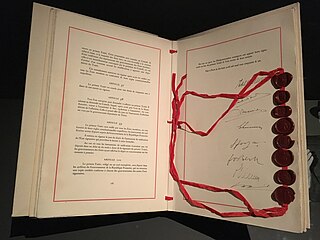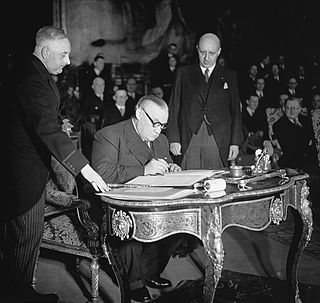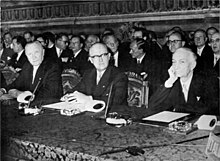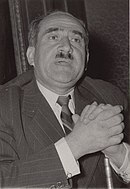
The European Coal and Steel Community (ECSC) was a European organization created after World War II to regulate the coal and steel industries. It was formally established in 1951 by the Treaty of Paris, signed by Belgium, France, Italy, Luxembourg, the Netherlands, and West Germany. The ECSC was an international organization based on the principle of supranationalism, and started a process of integration which ultimately led to the creation of the European Union.

The European Economic Community (EEC) was a regional organization created by the Treaty of Rome of 1957, aiming to foster economic integration among its member states. It was subsequently renamed the European Community (EC) upon becoming integrated into the first pillar of the newly formed European Union in 1993. In the popular language, however, the singular European Community was sometimes inaccuratelly used in the wider sense of the plural European Communities, in spite of the latter designation covering all the three constituent entities of the first pillar.

The European Union is a geo-political entity covering a large portion of the European continent. It is founded upon numerous treaties and has undergone expansions and secessions that have taken it from six member states to 27, a majority of the states in Europe.

The Treaty of Rome, or EEC Treaty, brought about the creation of the European Economic Community (EEC), the best known of the European Communities (EC). The treaty was signed on 25 March 1957 by Belgium, France, Italy, Luxembourg, the Netherlands and West Germany, and it came into force on 1 January 1958. Originally the "Treaty establishing the European Economic Community", and now continuing under the name "Treaty on the Functioning of the European Union", it remains one of the two most important treaties in what is now the European Union (EU).

The Treaty of Paris was signed on 18 April 1951 between France, Italy, West Germany, Belgium, Luxembourg, and the Netherlands, establishing the European Coal and Steel Community (ECSC), which subsequently became part of the European Union. The treaty came into force on 23 July 1952 and expired on 23 July 2002, exactly fifty years after it came into effect.

The European Communities (EC) were three international organizations that were governed by the same set of institutions. These were the European Coal and Steel Community (ECSC), the European Atomic Energy Community, and the European Economic Community (EEC); the last of which was renamed the European Community (EC) in 1993 by the Maastricht Treaty establishing the European Union. The European Union was established at that time more as a concept rather than an entity, while the Communities remained the actual subjects of international law impersonating the rather abstract Union, becoming at the same time its first pillar. In the popular language, however, the singular European Community was sometimes inaccurately used interchangeably with the plural phrase, in the sense of referring to all three entities. The European Coal and Steel Community ceased to exist in 2002 when its founding treaty expired. The European Community was merged with the second and third EU pillars by the Treaty of Lisbon in 2009, finally allowing the European Union to move beyond being only a concept and to assume the shape of a legally incorporated international organization with juridical personality, designated as the legal successor to the Community. However, the reformed EU has not become entirely unified, because Euratom, though governed with the EU by the common set of institutions, has been retained as an entity distinct from the EU, along with a number of other international entities, such as the European Investment Bank, the European University Institute, the European Stability Mechanism, and the Unified Patent Court.

An entity to be named the European Political Community (EPC) was proposed in 1952 as a combination of the existing European Coal and Steel Community (ECSC) and the proposed European Defence Community (EDC). A draft EPC treaty, as drawn up by the ECSC assembly, would have seen a directly elected assembly, a senate appointed by national parliaments and a supranational executive accountable to the parliament.

The special territories of members of the European Economic Area (EEA) are the 32 special territories of EU member states and EFTA member states which, for historical, geographical, or political reasons, enjoy special status within or outside the European Union and the European Free Trade Association..
The Merger Treaty, also known as the Treaty of Brussels, was a European treaty which unified the executive institutions of the European Coal and Steel Community (ECSC), European Atomic Energy Community (Euratom) and the European Economic Community (EEC). The treaty was signed in Brussels on 8 April 1965 and came into force on 1 July 1967. It set out that the Commission of the European Communities should replace the High Authority of the ECSC, the Commission of the EEC and the Commission of Euratom, and that the Council of the European Communities should replace the Special Council of Ministers of the ECSC, the Council of the EEC and the Council of Euratom. Although each Community remained legally independent, they shared common institutions and were together known as the European Communities. This treaty is regarded by some as the real beginning of the modern European Union.

Between 1993 and 2009, the European Union (EU) legally comprised three pillars. This structure was introduced with the Treaty of Maastricht on 1 November 1993, and was eventually abandoned on 1 December 2009 upon the entry into force of the Treaty of Lisbon, when the EU obtained a consolidated legal personality.
- The European Communities pillar handled economic, social and environmental policies. It comprised the European Community (EC), the European Coal and Steel Community, and the European Atomic Energy Community (EURATOM).
- The Common Foreign and Security Policy (CFSP) pillar took care of foreign policy and military matters.
- Police and Judicial Co-operation in Criminal Matters (PJCCM) brought together co-operation in the fight against crime. This pillar was originally named Justice and Home Affairs (JHA)
The Euratom Treaty, officially the Treaty establishing the European Atomic Energy Community, established the European Atomic Energy Community. It was signed on 25 March 1957 at the same time as the Treaty establishing the European Economic Community.

The Treaty of Brussels, also referred to as the Brussels Pact, was the founding treaty of the Western Union (WU) between 1948 and 1954, when it was amended as the Modified Brussels Treaty (MTB) and served as the founding treaty of the Western European Union (WEU) until its termination in 2010. The treaty provided for the organisation of military, economic, social and cultural cooperation among member states as well as a mutual defence clause.

The year 1948 marked the beginning of the institutionalised modern European integration. With the start of the Cold War, the Treaty of Brussels was signed in 1948 establishing the Western Union (WU) as the first organisation. In the same year, the International Authority for the Ruhr and the Organization for European Economic Co-operation, the predecessor of the OECD, were also founded, followed in 1949 by the Council of Europe, and in 1951 by the European Coal and Steel Community, with the ensuing moves to create further communities leading to the Treaty of Rome (1957)

This is a timeline of European Union history and its previous development.

The Spaak Committee was an Intergovernmental Committee set up by the Foreign Ministers of the six Member States of the European Coal and Steel Community (ECSC) as a result of the Messina Conference of 1955. The Spaak Committee started its work on 9 July 1955 and ended on 20 April 1956, when the Heads of Delegation of the six Member States of the ECSC approved the Spaak report. The committee worked on two main topics, one was the creation of a general common market and the other one was the establishment of a European Community for the peaceful use of atomic energy.

The High Authority was the executive branch of the former European Coal and Steel Community (ECSC). It was created in 1951 and disbanded in 1967 when it was merged into the European Commission.

This is a list of current, amended, spent and repealed Acts of the Parliament of the United Kingdom relating to its former membership and current relationship to the European Communities and the European Union from 1972 onwards.

This article outlines the history of the Common Security and Defence Policy (CSDP) of the European Union (EU), a part of the Common Foreign and Security Policy (CFSP).

The European Schools is an intergovernmental organisation, which has established, finances, and administers a small group of multilingual international schools, bearing the title "European School", which exist primarily to offer an education to the children of European Union (EU) staff; offers accreditation to other schools, bearing the title "Accredited European School", under national jurisdiction within EU member states to provide its curriculum; and oversees the provision of the secondary school leaving diploma, the European Baccalaureate.

The EU–UK Trade and Cooperation Agreement (TCA) is a free trade agreement signed on 30 December 2020, between the European Union (EU), the European Atomic Energy Community (Euratom), and the United Kingdom (UK). It provisionally applied from 1 January 2021, when the Brexit transition period ended, before formally entering into force on 1 May 2021, after the ratification processes on both sides were completed: the UK Parliament ratified on 30 December 2020; the European Parliament and the Council of the European Union ratified in late April 2021.



















